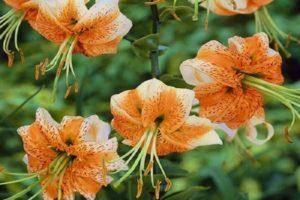Description and characteristics of the spider lily, planting, growing and care
The homeland of the spider lily is Japan. There, the flower is called higanbana. We know several more names of this decorative culture: resurrected lily, lycoris, golden amaryllis. A flower of amazing beauty is shrouded in a haze of mystery, however, like all representatives of the East. There are many legends and stories about him. Having settled the houses of such an exotic guest, you can tirelessly admire its decorativeness and bring the aroma of oriental culture and fairy tales to your home. There are no difficulties in caring for a spider lily.
Description and characteristics of lycoris
Belongs to the Amaryllis family, the spider lily has a bulbous root system that makes it look like daffodils and tulips. A characteristic of the culture that made her the heroine of legends is that her leaves and flowers never appear on the plant at the same time.
Unlike other bulbs, the spider lily has a rest period in the summer. And only in early September, the lycoris wakes up and throws out an escape. It is distinguished by very fast growth and within 4-5 days it grows 50 cm.After a short period of time, about 5 buds are formed on each shoot, which are funnel-shaped and exude a magical heady aroma that spreads far beyond the garden plot.
The palette of buds is very diverse: there are golden, purple, orange, red, white shades of petals. The entire flowering period of a spider lily is rather short - only 10-12 days. And after the flower stalks wither, the lycoris demonstrates the beauty of its leaves. Moreover, they remain for the entire winter period, and disappear only by June.
This culture is usually planted in cemeteries, for which it received another name - the flower of death. It is believed that the spider lily is designed to decorate the afterlife of the departed.
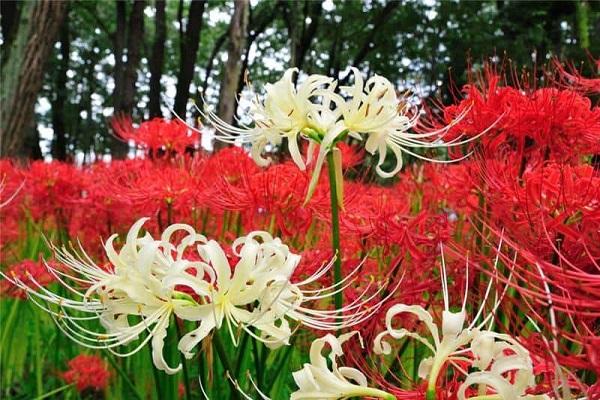
Advantages and disadvantages
Like every plant, the spider lily has its own strengths and weaknesses. The advantages of planting this ornamental crop include:
- Buds of extraordinary beauty.
- Bright aroma of blossoming flowers.
- Simplicity of care.
- No need for an annual transplant.
- Persistent immunity to diseases
Among the minuses of lycoris:
- Demanding to the composition of the soil.
- Draft sensitivity.
- The need for shelter for the winter in the northern regions.
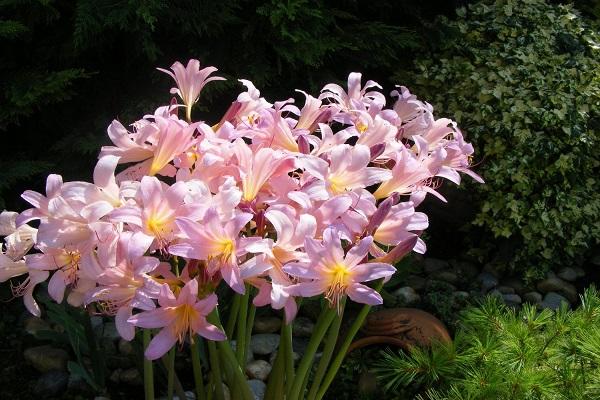
Flower types
Among several dozen representatives of this genus, there are several varieties that are successfully grown in the Russian climate.
Radiant
Reaches a height of 30 to 70 cm, the leaves are narrow, about 5-7 mm, some especially long bend from the center. With the arrival of autumn, pink or terracotta buds bloom on the radiant licorice. The petals have a characteristic feature - a narrow and long tendril leaning back. In the center there is a bundle of wide processes with wavy edges.
Scaly
The maximum height of the scaly lycoris growing in Japan is 70 cm.There is a rosette near the ground itself, it consists of bright green belt-shaped leaves, the width of which ranges from 1 to 3 cm.Flowering occurs in late August, when it forms on one stem about 8-9 buds. The color of the oval petals is light lilac. In the center of the flower are thin stamens. The flowering period is no more than 2 weeks.
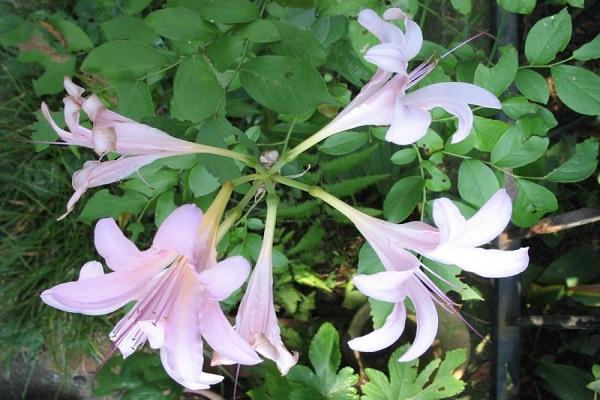
Blood red
One of the shortest varieties - its dimensions do not exceed 45 cm in height. The leaves are small, appear on the blood-red licorice in April, by June they turn yellow. On one large stem, 6 buds are formed, which have a bright scarlet color, their diameter does not exceed 5 cm.
Golden
In shape, this species resembles a radiant lycoris, but the color of its flowers is yellow. The petals are characterized by a fringed curl; inside the flower there are snow-white stamens.
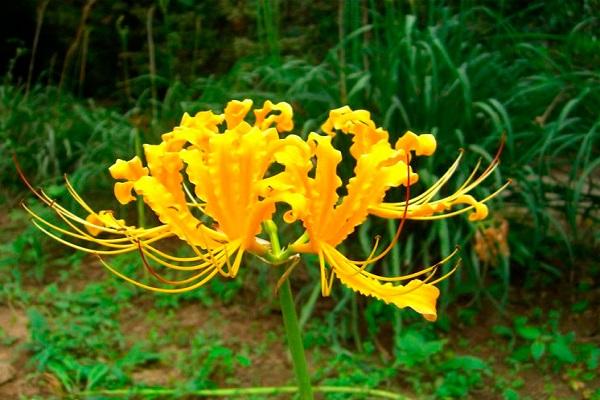
Features of growing an ornamental culture
To admire a rare exotic plant in your garden, you must strictly follow all the rules for planting and preparing the soil for a spider lily. The plant is not capricious, but it still has its own requirements for soil quality.
What time to plant
Experienced flower growers call autumn the best time for planting a spider lily in the garden. Moreover, it is important to take into account that at least a month remains for the first drops in temperature to minus indicators. In this case, the lycoris will have time to grow in a new place and adapt to the surrounding conditions. He will endure winter without problems, and already next autumn he will delight exotic beauty with flowers.
If, for some reason, the planting could not be carried out in the fall, it is allowed to do this in the spring, but in this case the spider lily may be sick, and the gardener will see flowering no earlier than in a year.
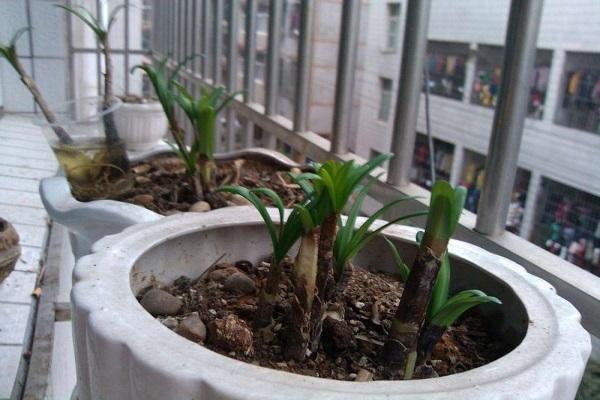
Site preparation and planting material
For planting a spider lily, a site is selected that is protected from blown winds and drafts. It is necessary to take into account that bright sunlight leaves burns on the lycoris foliage, therefore, place it in a light partial shade that falls from deciduous trees. In addition, in the bright sun, the buds of a spider lily will not be so colorful, their color will fade.
Before planting, they dig up the selected area and remove all the weeds so that it does not drown out the young flowers. The soil should be loose, sandy.
The spider lily bulbs are treated with any fungicide before planting in the ground or kept in a slightly pink solution of potassium permanganate.

Planting process
Step-by-step instructions for disembarking lycoris:
- Make holes about 15 cm deep in the selected and prepared area.
- When placing the bulbs, a distance of 25 cm is observed so that the flowers have enough nutrition.
- A small layer of river sand is laid at the bottom of the hole to improve the permeability of the soil.
- Gently press the material into the soil, sprinkle it with sand on top, if there are voids, fill them with soil.
- Spill the soil abundantly with water.
Experienced growers recommend laying a layer of mulch from fallen leaves or straw.
How to properly care for a flower
The decorativeness and health of an exotic guest depends on compliance with the rules of care.
Top dressing
Although the spider lily is quite capable of providing itself with nutrients by pulling them out of the soil, in some cases additional fertilization is necessary. They are guided by the appearance of the lycoris - if it has suspended its growth, has become sluggish, they bring in mineral compositions suitable for bulbous plants. This is done only 2 hours after irrigation, otherwise top dressing will simply burn the bulb and destroy the culture.
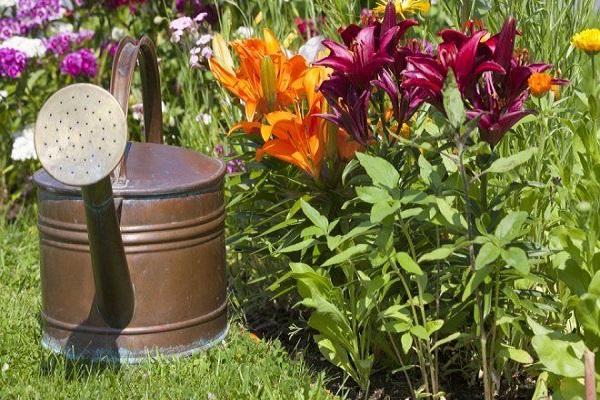
Watering
During the period of budding and leaf formation, the spider lily requires abundant and regular irrigation. Even a short-term drying out of the earth should not be allowed, this will certainly affect the decorative qualities of lycoris.
In the summer dormant period, when the leaves have wilted, and the flowers have not yet appeared, the moisture is completely stopped.
Transfer
Frequent transplanting of a spider lily is not necessary. In one place, the culture grows quietly for 5 years, but after this time, the licoris will have to be moved to a new site. If this is not done in time, the flower begins to ache and eventually dies.
Preparing for winter
For the winter, spider lily bulbs do not need to be removed from the ground. However, the peduncle is necessarily cut out after flowering, it draws out all the juices from the plant and interferes with its full preparation for the cold. If the region has cold and little snowy winters, cover the bulbs with a layer of foliage or spruce branches. This is enough for the successful wintering of a spider lily.
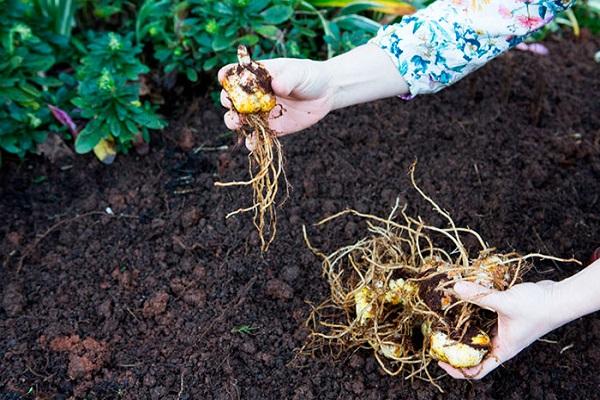
Diseases, pests and ways to control them
The spider lily demonstrates strong immunity to diseases and insect pests. The fact is that there are phytoncides in the foliage of lycoris that protect the plant from these problems. The only pest that occasionally infects the flower is the daffodil fly. They fight it with the help of a solution of any systemic insecticide, watering the area during the active growing season of the plant.
Breeding rules
Most often, flower growers use daughter bulbs that regularly form on the mother plant to breed lycoris. The seed method for breeding a spider lily is rarely used, since the material has a very low germination rate.
Application in garden design
Landscape designers recommend combining lycoris in plantings with low-growing plants that have similar care requirements. Spectacular flower arrangements are created with begonias, crocuses, ferns and anemones. The spider lily also looks good in rockeries and alpine slides in combination with delphiniums and irises.
